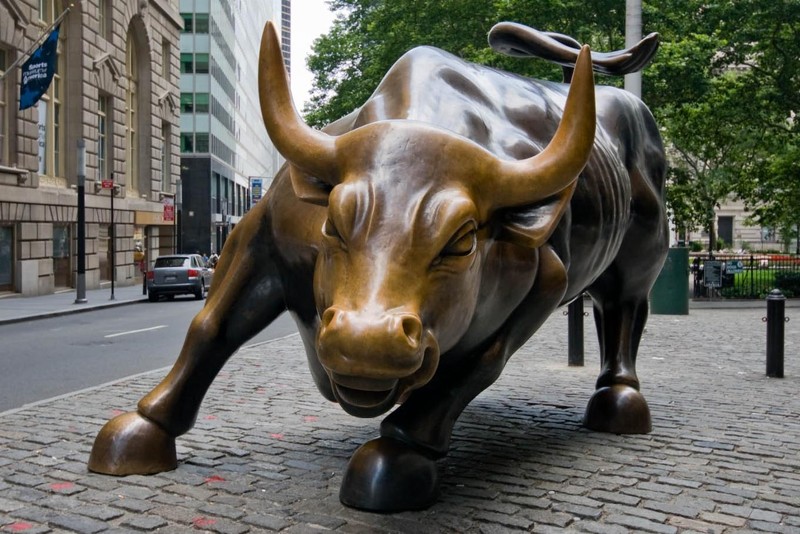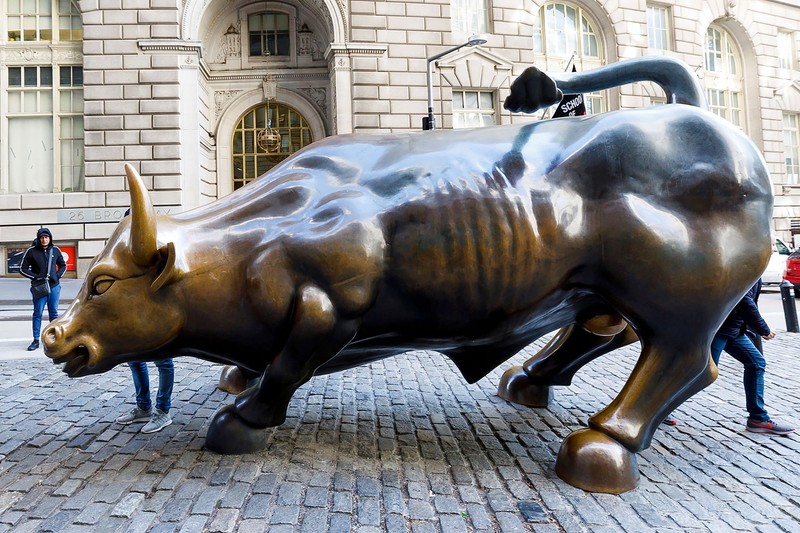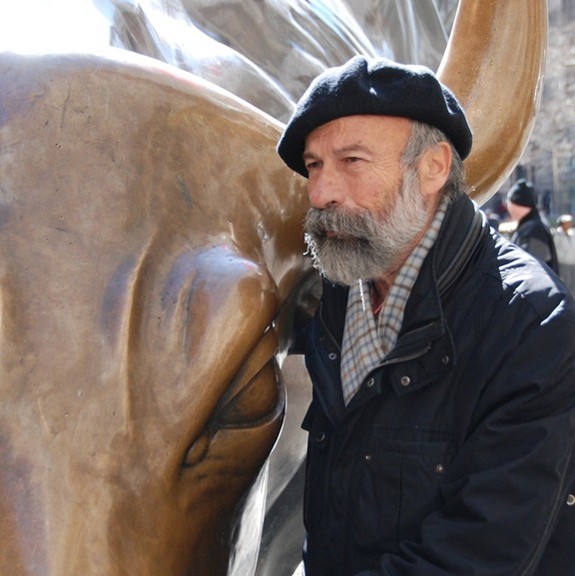Charging Bull
Introduction
Text-to-speech Audio
Images
Charging Bull (frontal view)

Charging Bull (side view)

Arturo Di Modica

Backstory and Context
Text-to-speech Audio
On Monday October 19, 1987, stock markets across the world collapsed suddenly and precipitously. In the United States, on what would henceforth be referred to as “Black Monday,” the stock market crashed. The Dow Jones Industrial Average lost nearly twenty-three percent of its total value over the course of the trading day. It was the largest one-day stock market decline in history, even greater than the stock market crash of the fall of 1929, which preceded the Great Depression.
Soon after “Black Monday,” Italian-American sculptor Arturo Di Modica went to work creating a statue that would symbolize American resiliency and inspire hope for the future in the wake of the unprecedented stock market downturn. After two years of hard work and more than $350,000 of his own money, the result was Charging Bull, a sixteen-foot-long, eleven-foot-tall, seven-thousand-pound (3.5-ton) bronze bull. Late on the night of December 15, 1989, Di Modica and his accomplices transported the statue on a flatbed truck and placed it under a sixty-foot-tall Christmas tree that stood in front of the New York Stock Exchange in Lower Manhattan. Before leaving the scene, Di Modica and his men scattered leaflets informing readers about his creation. While many people arriving for work the next morning were delighted to see the piece of guerrilla art, Dick Grasso, chairman of the New York Stock Exchange, was not. He spent the entire day attempting to remove it, finally succeeding in hiring a truck to haul it away. The truck deposited the statue in an impound lot in Queens, where it seemed destined to rot. Meanwhile, increasing public outcry over the statue’s removal impelled New York City Parks Department commissioner, Henry J. Stern, to act. He arranged for the bronze bull to be temporarily placed in Bowling Green, a small public park in Lower Manhattan and the closest one to Wall Street. On December 20, only four days after the statue was removed from the front of the New York Stock Exchange, city workers installed it in the park. The following day, Stern officially unveiled it. Despite the fact that Bowling Green was intended originally to serve as its temporary home, the bronze statue remains in the park to this day and has become one of the most significant tourist attractions in Lower Manhattan.
Over the years, Charging Bull has witnessed protests, suffered vandalism, and survived attempts by public officials to relocate it. In 2011, members of the Occupy Wall Street movement gathered around the bronze statue for weeks to protest economic inequality. In September 2019, a man attacked the sculpture with a steel-reinforced banjo, damaging one of its horns. The following month, climate-change protestors doused the statue in fake blood. In response to the episodes of vandalism, New York City mayor Bill de Blasio proposed relocating the bronze sculpture, citing public safety concerns. Public outcry followed. Joining in on the loud opposition to the mayor’s proposal was Di Modica himself. In June 2020, the Public Design Commission of New York, the city government agency that oversees the placement of works of architecture and art on city-owned property, rejected Mayor de Blasio’s proposal.
Sources
"Bowling Green." New York City Department of Parks and Recreation. The City of New York. Web. 1 December 2020 <https://www.nycgovparks.org/parks/bowling-green/history>.
Cascone, Sarah. "Charging Bull, Symbol of Wall Street's Roaring Market, Will Remain in Place After a Vote Nixes New York Mayor de Blasio's Plan to Move It," Artnet News, June 23, 2020 <https://news.artnet.com/art-world/mayor-cant-move-charging-bull-design-commission-says-1889235>.
Durante, Dianne L. Outdoor Monuments of Manhattan: A Historical Guide. New York: New York University Press, 2007.
Knight, Gladys L. Pop Culture Places: An Encyclopedia of Places in American Popular Culture. Vol. 1, A-F. Santa Barbara, CA: ABC-CLIO, 2014.
Nevius, Michelle and James Nevius. Inside the Apple: A Streetwise History of New York City. New York: Free Press, 2009.
Winck, Ben. "Wall Street's 'Charging Bull' statue will be relocated after drawing protests for years," Business Insider, November 8, 2019 <https://markets.businessinsider.com/news/stocks/wall-street-charging-bull-statue-scheduled-relocation-stock-exchange-2019-11-1028673614>.
https://www.artsy.net/article/artsy-editorial-charging-bull-symbol-new-york-site-activism
https://nypost.com/2019/11/13/de-blasio-backs-down-charging-bull-statue-to-stay-put-for-now/
https://news.artnet.com/art-world/wall-street-bull-relocation-1708023
